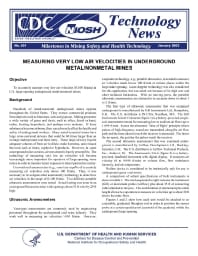Mining Publication: Technology News 501 - Measuring Very Low Air Velocities in Underground Metal/Nonmetal Mines
Original creation date: January 2003
Authors: WD Mayercheck, RJ Timko
NIOSHTIC2 Number: 20022292
Pittsburgh, PA: U.S. Department of Health and Human Services, Public Health Service, Centers for Disease Control and Prevention, National Institute for Occupational Safety and Health, Technology News 501, Jan. 2003; :1-2
The objective is to accurately measure very low air velocities (0-100 ft/min) in U.S. large-opening underground metal/nonmetal mines. Hundreds of metal/nonmetal underground mines operate throughout the United States. They extract commercial products from deposits such as limestone, salt, and gypsum. Mining generates a wide variety of gases and dusts, such as silica, diesel exhaust, radon, blasting byproducts, and perhaps even methane. If these substances become airborne, they can adversely affect the health and safety of underground workers. Many metal/nonmetal mines have large cross-sectional airways that could be 60 times larger than an average underground coal mine entry. These large airways require adequate volumes of fresh air to dilute, make harmless, and exhaust the toxic and, at times, explosive byproducts. However, in some underground mine sections, air movement is barely perceptible. The technology of measuring very low air velocities will become increasingly more important for operators of large-opening stone mines in order to monitor miner exposure to diesel particulate matter. Conventional anemometers (e.g., vane) are capable of accurately measuring air velocities only above 100 ft/min. Thus, it was necessary to investigate other anemometry technology to detect low air velocities in the range of 0-100 ft/min. Two different portable ultrasonic anemometers were tested. Actual testing was done in an underground limestone mine with openings about 51 ft wide by 29 ft high.

NIOSHTIC2 Number: 20022292
Pittsburgh, PA: U.S. Department of Health and Human Services, Public Health Service, Centers for Disease Control and Prevention, National Institute for Occupational Safety and Health, Technology News 501, Jan. 2003; :1-2
- Electromagnetic Noise in Lucky Friday Mine
- Novel Stopping Designs for Large-Opening Metal/Nonmetal Mines
- Propagation of EM Signals in Underground Metal/Non-Metal Mines
- Propagation of EM Signals in Underground Metal/Non-Metal Mines: Magma Copper Company - San Manuel Mine
- Relationship Between Elemental Carbon, Total Carbon, and Diesel Particulate Matter in Several Underground Metal/nonmetal Mines
- Risk Profile of Cumulative Trauma Disorders of the Arm and Hand in the U.S. Mining Industry
- Silica Dust Sources in Underground Metal/Nonmetal Mines - Two Case Studies
- Technology News 491 - NIOSH Releases Two New Safety Training Videos
- Technology News 518 - Super Stopping: A Permanent Solid Stopping for Directing Ventilation Airflows in Large-opening Metal/Nonmetal Mines
- Technology News 519 - EZ-Up Curtain Stoppings: A Practical Solution for Directing Ventilation Airflows in Large-opening Metal/Nonmetal Mines